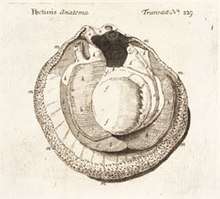Susanna Lister
Susanna Lister or Susanna Knowler (c. 1670 – 8 March 1738) was a British natural history illustrator and engraver who with her sister, Anne Lister created over 1,000 shell illustrations.
Susanna Lister | |
|---|---|
| Born | 1670 |
| Died | 8 March 1738 |
| Nationality | Great Britain |
| Other names | Susanna Knowler |
| Occupation | illustrator |
| Known for | illustrating shells |
| Spouse(s) | Gilbert Knowler |
| Children | one |
Life
Lister was born in Carleton-in-Craven and baptised in 1670. She had a younger sister Anne Lister and six other siblings. Her parents were Helen and Martin Lister. She was born at Carleton Hall although her father had a residence in York.[1]
By the time she was eleven her polymath father was allowing her and her sister to experiment with oil paint but he prevented then from doing any serious limning until her had given them instruction.[1]

Her father had a large collection of seashells and they would learn how to draw these accurately. Martin Lister published a book of shell illustrations titled "De cochleis" and some of the illustrations are marked with "AL pni." and "SL" as attribution.[1] Their drawings were etched in Oxford.[2] They were some of the first women to use a microscope.[3][4] Susanna and her sisters work was used by their father because he considered that the best engravers were not equally reliable. The illustrations were thought to be essential by her father as he wanted them to distract observers from his interest in molluscs. He was a physician and he worried that his interests may be seen as eccentric.[5]
.jpg)
In 1685 Martin Lister published the first two volumes of his four volume book with the ambition of illustrating every shell. The books would included 1062 illustrations that were the work of Susanna or her sister. The books were a systemic study of what would become conchology.[6] Edward Lhwyd noted the enormous amount of work that the sisters donated to the task over some years. Women involved in scientific illustration at this time was unusual. Maria Sibylla Merian (and her daughters) are rare examples of others.[7]
In 1706 or 1707 she became the third wife of Gilbert Knowler who was about seven years older than her. They would have one daughter who was also called Susanna Knowler.[1]
Lister died in Bekesbourne. Her legacy is the illustrations and engravings that she created. It was believed that the copper plates were lost but her biographer, Anna Marie Roos, found that they were safely stored in the Bodleian Library.[5] Roos believes that one of the copper plates may be the oldest extant that were used for the Philosophical Transactions as all the similar plates were given as scrap during the shortages of World War One.[8]
Further reading
Martin Lister and his Remarkable Daughters by historian, Anna Marie Roos, was published by the Bodleian Library in 2018.[9]
References
- "Lister [married name Knowler], Susanna (bap. 1670, d. 1738), natural history illustrator". Oxford Dictionary of National Biography. doi:10.1093/ref:odnb/58454. Retrieved 2020-04-16.
- "Ontdek amateurtekenaar Susanna Lister". rkd.nl (in Dutch). Retrieved 2020-04-16.
- Ravilious, Kate (2 August 2015). "Terrawatch: The lost art of specimen illustration". The Guardian. ISSN 0261-3077. Retrieved 2020-03-23.
- Newman, Cathy (22 January 2019). "Art and science interweave in a tale of two talented sisters and their polymath father". Science. Retrieved 2020-03-23.
- Grahame, John (5 June 2019). "Coming out of one's shell: new book explores overlooked mollusc art by naturalist's daughters". The Art Newspaper. Retrieved 2020-04-16.
- "Historiae Conchyliorum. :: Natural History – Original Investigations". lhldigital.lindahall.org. Retrieved 2020-04-16.
- Tobin, Beth Fowkes (2018-10-09). "How seventeenth-century sisters broke the mould on scientific illustration". Nature. 562: 190–191. doi:10.1038/d41586-018-06944-7.
- Roos, Anna Marie (2012-03-20). "The Art of science: a 'Rediscovery' of the Lister Copperplates". Notes and Records of the Royal Society. 66 (1): 19–40. doi:10.1098/rsnr.2011.0053.
- Murphy, Kathryn (25 March 2019). "The making of a 17th-century book of shells". Apollo Magazine. Retrieved 2020-04-16.